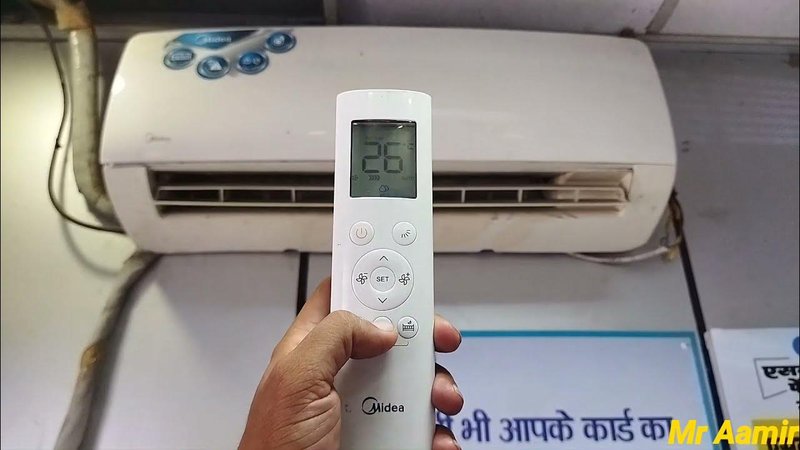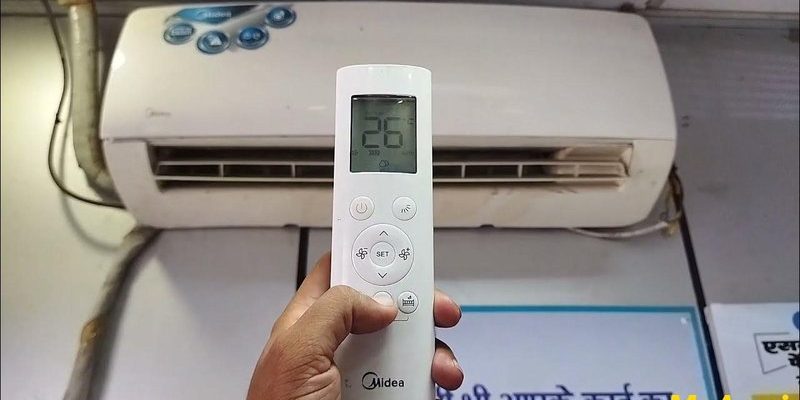
That’s what we’re chatting about here: the idea of using a single Midea AC remote for multiple units. It sounds as convenient as using one key for every door in your house. But, just like with keys and locks, there are quirks, limits, and a few little surprises in the fine print. Let me walk you through what’s possible, what’s not, and why it matters, especially if you’re new to the world of air conditioner remotes (and, let’s face it, most of us don’t sit around reading AC manuals for fun).
So, do Midea remotes have magic powers—or just a few simple tricks? Let’s get into it and save you some serious frustration (and maybe a few arguments with the remote).
How Midea AC Remotes Actually Work
At their core, **Midea AC remotes**—like basically all air conditioner remotes—use infrared (IR) technology. It’s kind of like an invisible flashlight: when you press a button, the remote blasts out an IR code that tells your AC what you want it to do. Think of it like Morse code, but for appliances. The Midea unit listens for that code and acts on it if it recognizes the “language.”
Here’s the thing: not every Midea remote speaks the exact same language. Midea has released dozens of models over the years. Some remotes are pretty basic (just ON/OFF and temperature), while others are fancier, with extra modes, swing controls, and timers. Each remote and each AC come programmed with their own set of codes.
This means that while some remotes can talk to multiple ACs, others might just end up getting ignored—like trying to shout across the room in a foreign language. It all depends on whether the *code* matches what the AC expects to hear.
If you’re curious, the way these remotes and units “pair” isn’t like WiFi or Bluetooth. There’s usually no complex setup. If a remote works, it just does—no special syncing or pairing routine required. But when it doesn’t, well, you’ll notice fast.
Will Any Midea Remote Work on Any Midea AC?
Now for the million-dollar question: can you just grab any Midea remote and run your entire fleet of ACs? The answer is… sometimes, but not always. Let me explain why.
Most Midea wall-split units from the same generation *do* share compatible codes, which means you can walk around and point one remote at several units (as long as they’re in view). But, if you’ve got a mix of models—say, a 2015 bedroom unit and a 2019 living room monster—they might not speak the same IR “language.” The new remote could have extra buttons your old AC doesn’t even recognize, or vice versa.
Here’s a personal example: I once tried to use my friend’s remote from his fancy new Midea to control my ancient bedroom unit. No dice. Mine just sat there, blinking like it was judging me. But when I tried a remote from a neighbor’s guest room (same age and look as mine), it worked perfectly.
So, if your Midea AC units are the same model—or at least from the same product line—there’s a much higher chance one remote will handle them all. If they’re from different series, you might be out of luck unless you snag a universal remote (more on that later).
What About Using a Single Remote for Two or More Units?
Let’s talk practical stuff. If you want one **Midea AC remote** to run two or more units, there’s a big *if*: the units must be within “line of sight.” Infrared can’t pass through walls or floors. You basically have to be able to “see” the sensor on the AC with your remote—no magic.
So, if both units are in the same room, or close together (think: living room and adjoining dining room), you can point and control both, often at once. Sometimes, you might accidentally turn both on or off—a little chaotic, but kind of fun if you’re trying to impress a cat.
Here’s a real-life tip: if each unit requires a different IR code (because they’re from different lines), your remote simply won’t work on both. Or, it might only do basic commands (like power on/off) while ignoring the rest. You may need to test button-by-button to see what sticks.
If you want a neat trick: some universal remotes allow you to “teach” them multiple code sets, so you switch between “profiles” for each unit. This is more advanced, but can totally solve the problem if you’re juggling lots of different Midea ACs in one house.
Remote Pairing, Syncing, and Resetting: How to Troubleshoot
So what if your remote used to work on multiple units, but now it’s stubborn? Or you just bought a replacement and it does, well, nothing? Here’s what you can try.
First, check the **battery**. Seems obvious, but a dying battery can make the IR beam too weak to reach even one AC, let alone two. Swap in some fresh AAAs and try again.
Next, give the **remote sensor** on each unit a quick wipe with a dry cloth. Dust can block the signal like sunglasses for your AC.
Still nothing? Some remotes have a *reset* button (often hidden in the battery slot). Pressing this can clear weird glitches or stuck codes. Some Midea units can also be reset—usually by unplugging for a minute, then powering back up. That’s the AC equivalent of turning it off and on again.
If you suspect the remote just isn’t compatible, you might be able to “recode” or “pair” it. For Midea originals, this is rare—most just work out of the box, no pairing required. But double-check the instruction manual or look for a tiny pinhole labeled “code” or “sync.” Sometimes you’ll hold down that button while pointing at the unit, and voilà: success.
If your remote still ignores one or more units after these steps, the odds are it’s just not compatible. Time to look for a matching remote model number, or consider a universal replacement.
Universal Remotes vs Midea Brand Remotes: Pros and Cons
So what about **universal remotes** for air conditioners? They’ve come a long way since the days of clunky TV clickers. If you’re tired of juggling multiple remotes (and maybe losing one under the dog), a universal remote can be a lifesaver.
The big win: universals can store codes for many brands and models, including most Midea ACs. Some even let you assign different buttons (or profiles) for different units. Just follow the instructions to “teach” the remote which code works for each AC. Suddenly, you can run the show with one gadget.
But here’s the catch: universals sometimes only support basic features (power, temp, fan), not every fancy mode or setting. So if you love that “dehumidify while swinging” super-mode, your universal may shrug. Also, programming them can be a headache—lots of tiny numbers, trial, and error.
My advice? If you mostly use ON/OFF, temp, and simple fan modes, a universal is a solid choice. If you want every bell and whistle, try to find a matching-original remote (check the Midea model number inside the battery compartment for clues).
The Importance of Model Numbers and IR Codes
This might sound boring, but stay with me: **model numbers and IR codes** are like the DNA of your remote and AC. The label inside your remote’s battery cover or on the back of your AC tells you *exactly* which models play nice together.
Before buying a replacement remote or trying to mix-and-match across multiple units, jot down these numbers. They’re a lifesaver if you ever have to order online or troubleshoot with Midea’s support. It’s like knowing your blood type before a transfusion—critical info when things go sideways!
If your remotes are lost or the stickers are faded, you can sometimes find compatible code lists online or by asking Midea dealers. It’s a little detective work, but saves you time and frustration.
Common Problems When Sharing a Remote (and Their Solutions)
Sharing a **Midea AC remote** between units sounds great, but in real life, little hiccups pop up. For example, pressing “ON” might turn on both units at once (good if you want to chill the whole house fast, less good if you just wanted your office cool).
Another snag: remote range and angle. IR signals can bounce off some surfaces, but if you’re standing in an awkward spot, one unit might get the signal while the other doesn’t. It’s like telling twins to come to dinner and only one actually hears you.
If your remote is inconsistent, try aiming more directly at each unit—or control them one-by-one. In rare cases, the IR sensors can degrade or get blocked (think: dust bunnies, pet hair, or, once, a kid’s glitter sticker—don’t ask).
If nothing’s working, remember those **troubleshooting** steps above: batteries, reset, line of sight, and model compatibility. Nine times out of ten, the fix is surprisingly simple.
Are There Smart Alternatives? (WiFi & App Controls)
It’s 2024, so of course someone’s figured out how to run their AC by phone. Many newer Midea models support **WiFi controls** via an app. This not only lets you use your phone as a remote, but also control units from anywhere—even while you’re out grabbing groceries.
If both your units are WiFi-enabled and set up on the same app, you can ditch the physical remote altogether. Schedule, tweak, or crank the AC for whichever room you want, whenever you want. No more missing remotes, and *definitely* no more arguments about who left the AC on.
But if you’ve got older models, you’re probably better off sticking to IR remotes or picking up a universal one. Just check your manual for “WiFi” or “smart control” mentions before you get too excited.
Wrapping Up: What’s the Best Move for You?
So, can a **Midea AC remote** control multiple units? The honest answer: *sometimes*—if your models match up, if the remotes are compatible, and if you’re in the same room. It’s a handy trick that can save a little hassle, but it’s not guaranteed with every model or every setup.
If you’re not sure, spend two minutes checking your model numbers and testing button-by-button. For more flexibility (or for running a whole house of different-brand ACs), a universal remote or a smart app might be your best friend. And if all else fails, a fresh set of batteries and a quick sensor wipe never hurt anyone.
Who knew AC remotes could be so complicated? But hey—mastering the remote means mastering summer comfort, and that’s always worth a little extra effort.
